Have you ever felt like a painter with a blank canvas in front of you, ready to create a masterpiece? That’s the feeling you get when you write with a fountain pen. The ink flows effortlessly from the nib, creating a smooth and satisfying stroke that makes your handwriting look like a work of art.
But what happens when the ink runs out? Don’t worry, refilling your fountain pen is easy and will keep you inspired to continue writing with style and elegance.
In this article, we will guide you through the step-by-step process of refilling your fountain pen with ink. We will cover the different types of ink, how to prepare your pen for refilling, choosing the right ink, the actual refilling process, troubleshooting tips, and storing your pen properly.
So, get ready to unleash your creativity and take your writing to the next level with the simple act of refilling your fountain pen with ink.
Key Takeaways
– Preparing the pen for refilling is important, including cleaning it with water or a converter and choosing the right ink cartridge.
– When refilling, it’s crucial to avoid overfilling to prevent leaks and to troubleshoot any issues with consistency or clogged nibs.
– Proper storage of the pen, such as keeping it in a cool, dry place and handling it carefully to avoid spills, is important to maintain its quality.
– Refilling a fountain pen with ink can elevate the writing experience and unleash creativity with unique ink characteristics and colors.
Types of Fountain Pen Ink
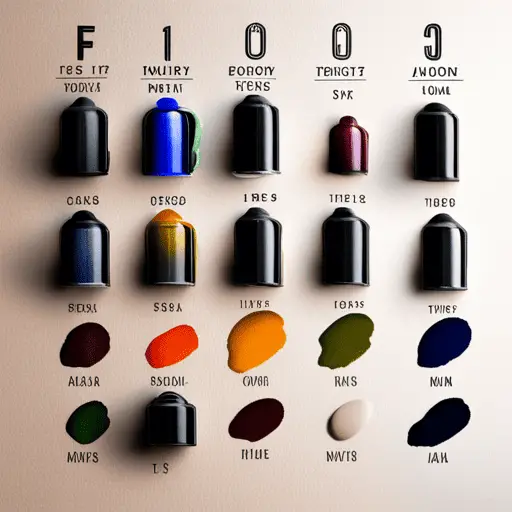
There’s a wide variety of fountain pen inks to choose from, each with their own unique characteristics and colors. When it comes to ink viscosity, you’ll find that some inks are thicker and more viscous, while others are thinner and more runny.
The viscosity of ink can affect how smoothly it flows through your pen’s nib and onto the paper, so it’s important to choose an ink that matches your pen’s nib size and writing style.
Color options are another important factor to consider when choosing a fountain pen ink. From bold and bright hues to muted and subtle tones, there’s a color for every mood and occasion. Some inks are even designed to change color as they dry, adding a touch of magic to your writing.
With so many options to choose from, you can easily find an ink that fits your personal style and makes your writing stand out.
Preparing Your Pen for Refilling
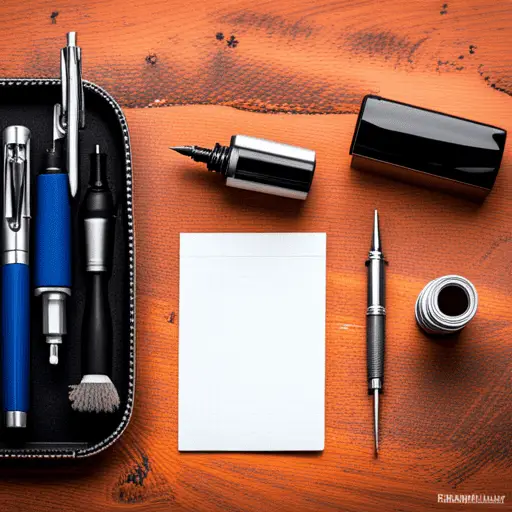
Before you can start pouring in the new liquid, it’s crucial to make sure that your trusty writing tool is completely empty of any remnants from the last time you used it. The cleaning process is essential in preparing your pen for refilling.
You can clean your fountain pen by flushing it with water or using a converter to suck out any leftover ink. Make sure to remove the ink cartridge or converter from the pen before cleaning it.
Once your fountain pen is clean, it’s time to choose the right ink cartridge options. You can opt for a standard international cartridge, a proprietary cartridge, or use bottled ink with a converter.
If you’re unsure which option to choose, consult your pen manufacturer’s guide or discuss this with a fountain pen expert. By properly preparing your pen for refilling and choosing the right ink cartridge options, you can ensure that your fountain pen will provide you with the smoothest writing experience possible.
Choosing the Right Ink
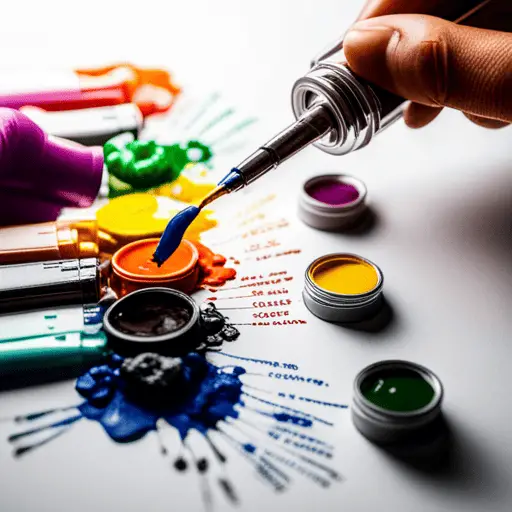
To create the perfect writing experience, it’s important that you select an ink that reflects your personal style and taste. There are a wide variety of ink colors to choose from, so you can pick one that matches your mood or the occasion.
For example, if you want to convey a formal and professional tone, black or blue-black ink is a good choice. If you want to inject some fun and personality into your writing, you can go for bright and bold colors like pink, purple, or green.
Another important factor to consider when choosing the right ink is the brand. Some popular ink brands include Parker, Waterman, and Montblanc. Each brand has its own unique qualities and characteristics that can enhance your writing experience.
For instance, Parker Quink ink is known for its fast-drying formula, while Waterman ink has a smooth and consistent flow. Montblanc ink, on the other hand, is renowned for its high-quality and luxurious feel. By selecting the right ink brand for your fountain pen, you can ensure that your writing is not only stylish but also functional.
The Refilling Process
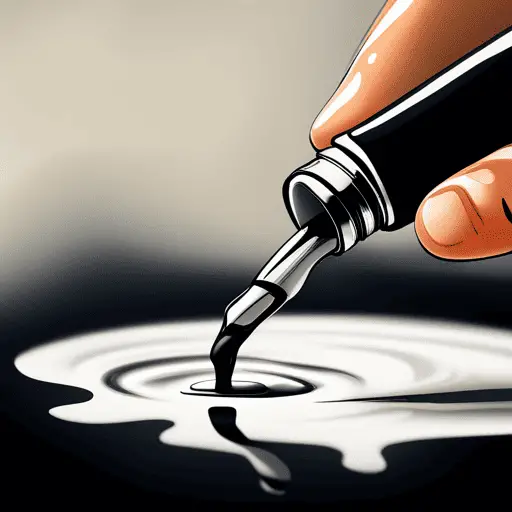
Now that you’ve selected the perfect ink for your writing needs, it’s time to learn how to refill your fountain pen. This process is simple, but it’s important to avoid common mistakes to prevent messy spills and leaks. Here are some expert tips to help you refill your fountain pen with ease:
First, make sure your fountain pen is clean and dry before you begin. Next, unscrew the pen’s barrel to expose the ink reservoir. Use a dropper or syringe to draw ink from your ink bottle, and slowly and carefully fill the reservoir to about 80% full. Be sure not to overfill the reservoir, as this can cause ink to leak out. Finally, reassemble the pen, and gently shake it to ensure the ink is well-distributed.
To help you visualize the process, consider the following table:
| Step | Action | Tips |
|---|---|---|
| 1 | Prepare pen | Make sure it’s clean and dry |
| 2 | Unscrew barrel | Expose ink reservoir |
| 3 | Fill reservoir | Use dropper or syringe, fill to 80% |
| 4 | Reassemble pen | Ensure ink is well-distributed |
| 5 | Shake pen | Helps distribute ink evenly |
By following these expert tips and carefully refilling your fountain pen, you can keep your writing flowing smoothly and avoid any unexpected ink spills or leaks. Happy writing!
Troubleshooting Tips
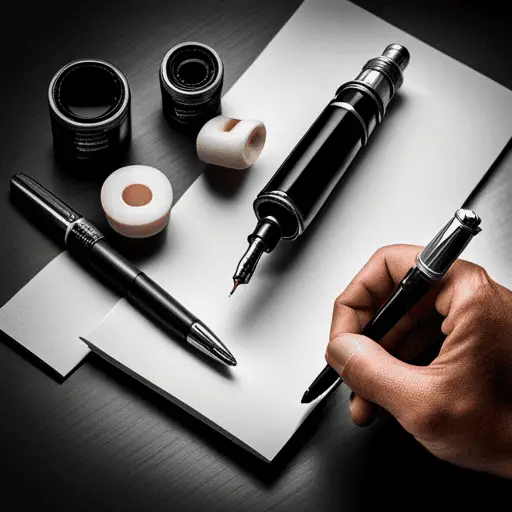
If you’re experiencing frustrating ink flow issues or troublesome leaks, don’t give up on your beloved writing instrument just yet! There are some troubleshooting tips that you can try before giving up on your fountain pen.
Firstly, check the ink consistency. If the ink is too thick or thin, it can cause issues with ink flow. You can add a few drops of water to thin out thick ink or use a more concentrated ink if the ink is too thin.
Additionally, some inks may take longer to dry than others, which can result in smudging or ink transfer. If this is the case, try using a quicker-drying ink or waiting a little longer before handling the paper.
Another issue that can cause ink flow problems is a clogged nib. If your pen has been sitting unused for a while, the ink may have dried up and clogged the nib. To fix this, you can try soaking the nib in warm water or using a pen cleaning solution to remove any dried ink.
Lastly, if you’re still having trouble with ink flow, make sure that the pen is assembled correctly. Check that the converter or cartridge is seated properly and that the nib and feed are aligned.
By following these troubleshooting tips, you can keep your fountain pen in tip-top shape and enjoy a smooth writing experience.
Storing Your Pen
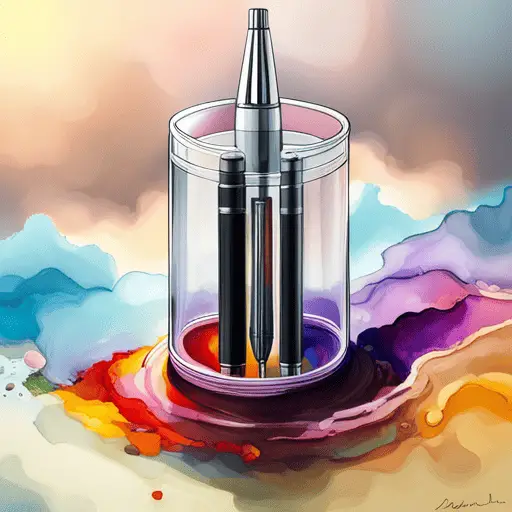
When it comes to storing your fountain pen, there are a few things you should keep in mind to ensure your pen stays in good condition. Proper storage techniques include keeping your pen in a cool, dry place and avoiding extreme temperatures.
Additionally, it’s important to be careful when handling your pen to avoid any potential ink spills.
Proper Storage Techniques
Properly storing your fountain pen after refilling it with ink is crucial to ensuring its longevity and optimal performance. Here are two tips to help you properly store your pen:
– Keep your pen in a cool, dry place: Humidity control is crucial to maintaining the quality of your pen. Keep it away from direct sunlight and in a place with good air circulation. This will prevent the ink from drying out or becoming too thick, which can clog the nib and reduce the pen’s performance.
– Consider ink cartridge alternatives: Ink cartridges tend to dry out quickly and can be expensive to replace. Consider using a converter or a refillable ink bottle instead. This will not only save you money in the long run but also allows you to experiment with different ink colors and types.
By implementing these storage techniques, you can ensure that your fountain pen stays in top condition for years to come. So, go ahead and indulge in your love for fountain pens, and innovate your writing experience with these simple yet effective tips.
Avoiding Ink Spills
Don’t let a messy desk ruin your writing experience with fountain pens – avoid ink spills with these easy tips.
First, make sure to fill your pen over a clean surface. Lay down a paper towel or use a dedicated ink well to catch any drips or spills. This will prevent ink from staining your desk or clothing.
Secondly, be mindful of the ink level in your pen. Overfilling can cause ink to leak out of the pen’s nib, while underfilling can create air bubbles that disrupt ink flow. If you’re using ink cartridges, make sure they’re properly inserted and secured before writing.
And if you do experience an ink spill, don’t panic – there are many cleaning techniques available to remove ink stains from various surfaces.
By following these simple steps, you can enjoy the smooth writing experience of a fountain pen without the fear of messy accidents.
Conclusion
Congratulations! You’ve successfully refilled your fountain pen with ink.
Remember, there are many types of fountain pen ink available, and it’s important to choose the right one for your pen. Take the time to prepare your pen for refilling, and always follow the instructions provided by the manufacturer.
If you encounter any issues during the refilling process, don’t panic. Troubleshoot the problem and try again.
Once you’re done, be sure to store your pen properly to ensure it stays in top condition.
As the saying goes, “the pen is mightier than the sword.”With your newly refilled fountain pen, you have the power to write your thoughts, ideas, and dreams onto paper and make them a reality.
So go forth and conquer the world with your words!
